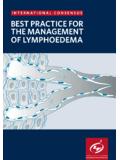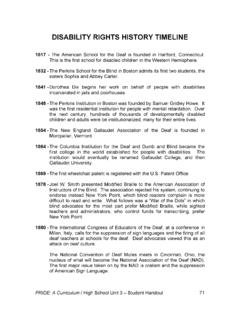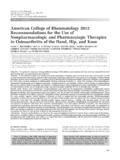Transcription of Double Gloving - A Standard of Practice in Surgery
1 A self STUDY GUIDE Double Gloving A Standard OF Practice IN SURGERYR egistered NursesDOUBLE Gloving A Standard OF Practice IN SURGERY2 OVERVIEWThe issues around personal protective equipment have never been more discussed than they are today. It is no surprise given the recent Ebola crisis and the amount of information we hear daily about hospital-associated infections, surgical site infections and antimicrobial resistance. As deadly viruses such as Ebola, hepatitis and human immunodeficiency virus become more prevalent in the population, awareness is increasing that such infections may be transmitted to healthcare workers (HCWs) through contaminated blood. Surgical gloves provide a protective barrier between HCWs hands and infectious blood and body fluid, but research has proven that surgical gloves cannot always withstand the rigors of lengthy and strenuous surgeries, and surgical personnel do not always change their gloves frequently enough during lengthy procedures.
2 When there is a breach, or barrier failure to a surgical glove, there is a subsequent potential for the transfer of pathogens to both the patient and the surgical team. From a risk management, infectious disease and occupational health perspective, prevention of barrier failure is key to protecting the surgical team and the patient. For members of the surgical team, the primary method of prevention is the Practice of Double Gloving for surgical procedures. Some surgeons and nurses have eagerly adopted the Practice while others have stubbornly refused, citing objections ranging from poor fit, feel and comfort of wearing two sets of gloves, to losing necessary tactile sensitivity required for intricate surgeries, all the way to administrative budget cuts that prevent the expense for extra gloves. In this education module you will explore two questions: is Double Gloving worth the effort and what does the evidence say?LEARNER OBJECTIVESA fter completing this continuing education activity, you should be able to:1.
3 Describe the stringent manufacturing requirements for surgical Discuss factors that could lead to surgical glove Identify healthcare workers injury and risks with single Identify the published advantages of Double Discuss how to implement Double Gloving best AUDIENCEThe information contained in this self -study guidebook is intended for use by healthcare professionals who are responsible for or involved in the following activities related to this topic: Educating healthcare personnel. Working in the operating room and other surgical environments. Establishing institutional or departmental policies and procedures Decision-making responsibilities for safety and infection prevention products. Maintaining regulatory compliance. Managing employee health and infection prevention is a Recognized Provider of continuing education by the California Board of Registered Nursing, provider #CEP 15538 and the Australian College of Perioperative Nurses (ACORN). This course has been accredited for 2 (two) contact hours.
4 Obtaining full credit for this offering depends on completion of the self -study materials on-line as directed refers to recognition of educational activities only and does not imply endorsement of any product or company displayed in any form during the educational receive contact hours for this program, please go to the Program Tests area and complete the post test. You will receive your certificate via 85% PASSING SCORE IS REQUIRED FOR SUCCESSFUL COMPLETION. Any learner who does not successfully complete the post-test will be notified and given an opportunity to resubmit for more information about our educational programs or perioperative safety solution topics, please contact: Ansell Healthcare Educational Services by e-mail at Committee Members:Luce Ouellet, BSN, RNLatisha Richardson, MSN, BSN, RNPatty Taylor, BA, RNPamela Werner, MBA, BSN, RN, CNORAs employees of Ansell Mrs. Ouellet, Mrs. Richardson, Mrs. Taylor and Ms. Werner have declared an affiliation that could be perceived as posing a potential conflict of interest with development of this self -study module.
5 This module will include discussion of commercial products referenced in generic terms OF CONTENTS INTRODUCTION ..2 HISTORY OF GLOVES .. 4 MANUFACTURE OF GLOVES .. 4 FACTORS IMPACTING GLOVE FAILURE .. 6 GLOVE WEARER ROLE .. 7 TIME OF WEAR LENGTH OF CASE ..8 Double Gloving RESEARCH .. 8 HEALTHCARE WORKER RISK AND INJURY .. 9 RESEARCH ON CHANGE .. 11 Double Gloving TECHNIQUE .. 12 TWO-COLOR GLOVE SYSTEM .. 12 ORGANIZATIONAL RECOMMENDATIONS .. 13 BEST GLOVE practices .. 13 CONCLUSION .. 13 REFERENCES .. 14 BIBLIOGRAPHY .. 16 Double Gloving A Standard OF Practice IN SURGERY4 HISTORY OF SURGICAL GLOVESG loves were first introduced into the surgical arena during the 1890s when Dr. William Halstead commissioned the Goodyear Rubber Company to make the first pairs to protect the hands of the nurses and surgical assistants from the harsh disinfecting agent, carbolic acid. They were crude and cumbersome at that time, but they did protect the workers hands from the harsh chemicals.
6 It soon became apparent that wearing the gloves also reduced the rate of post procedure infections among patients and decreased mortality. By the early 1900s, the use of surgical gloves was routinely used during Surgery in both Europe and the United Goodyear Surgical GloveThe first mention of Double Gloving in the medical literature came sometime later, during World War II. An orthopedic surgeon named Dr. Marshal R. Urst, a graduate of the Johns Hopkins University School of Medicine, joined the war effort in 1943. He was Chief of Orthopaedics in the 22nd General Hospital Division in England and the 97th General Hospital Division in Germany. He explained, as they explored wounds for bullet and shell fragments, that they wore two gloves because of the risk of tearing the glove on the sharp fragment of bone. The first disposable latex medical gloves with thinner fingers and palms were manufactured in 1964. Prior to this, surgical gloves were re-used, and had to be strong enough to withstand repeated washings and steam sterilizations.
7 In 1966, the world s first prepackaged, sterile surgical glove became available. MANUFACTURE OF GLOVESThe risk of exposure to bloodborne pathogens is a serious concern to healthcare providers, particularly those working in the operating room (OR). Given the serious health and cost implications related to the consequences of bloodborne infections, both OR staff and their patients need to be protected from the risk of these infections. 5 Surgical ProcedureSURGICAL GLOVE standards ARE GOVERNED BY NATIONAL GOVERNMENT STANDARDSQ uality specifications are written into each National Standard for a surgical glove product. They relate to physical requirements like strength, thickness, measurements, performance, and freedom from holes. Specifics include, elasticity, elongation, protein and powder levels, allergenicity or biocompatibility. These specifications require a statistical sample scheme which, if passed, mathematically ensures a maximum potential number of defined faults per 100 units.
8 This is called an AQL (Acceptable Quality Level). Batches of product are rejected by the manufacturer if the number of faults exceeds this number. Each Standard Organization has varying requirements to be met and generally arrange factory inspections before granting a Certificate of standards Conformity In Europe, medical gloves are subject to the European standards EN 455 part 1-2-3, while the enforcement is under the responsibility of each Member State through national standards bodies and healthcare agencies. The European EN 455 Standard for surgical gloves was approved by CEN (European Committee Standardization) which the members are the National standards bodies of Austria, Belgium, Bulgaria, Cyprus, Czech Republic, Denmark, Estonia, Finland, France, Germany, Greece, Hungary, Iceland, Ireland, Italy, Latvia, Lithuania, Luxembourg, Malta, Netherlands, Norway, Poland, Portugal, Romania, Slovakia, Slovenia, Spain, Sweden, Switzerland and United Kingdom. The US FDA does not write standards but it does recognize standards that are written by the American Society of Testing and Materials (ASTM).
9 Surgical gloves sold into the US must meet the ASTM standards . ISO (International Organization for Standardization) is an independent, non-governmental membership organization and the world s largest developer of voluntary International standards . Many countries require surgical gloves entering their country to meet the ISO PROVIDER SPECIFIC NEEDSM anufacturers must also produce gloves that meet the customer s specific individual needs for durability, flexibility, tactile sensitivity and resiliency. The gloves need to fit like a second skin for the surgeons that are performing delicate microsurgical procedures and be flexible enough to touch the tiny hair-like vessels of a premature infant s heart, in addition to having the durability to withstand the rigor of the chisels and blades during a total joint replacement while providing a barrier between the healthcare worker and the patient. The material must meet stringent manufacturing standards and also stringent tactile requirements at the same time all of this while still providing acceptable fit, feel and comfort throughout the procedure.
10 This is no small order to fill. Manufacturers have made great strides and improvements in gloves and have produced a large variety of quality products for HCWs to choose from including, Standard , orthopedic, sensitive, radiation attenuation, and so on. Even with all the high technology in manufacturing, there are several factors that increase the likelihood of glove failure during use, including mechanical stress, type of Surgery , number of instruments used in the surgical case, length of surgical procedure and the wearer s role in the surgical case . Glove ManufacturingDOUBLE Gloving A Standard OF Practice IN SURGERY6 FACTORS IMPACTING GLOVE FAILUREThe OR is a unique environment with inherent peculiarities that increase the chance of glove failure. Surgeons use sharp instruments and are exposed to sharp boney surfaces. Boney procedures have been associated with higher glove failure than soft-tissue , 3 The operating site is confined and visibility for the OR scrub nurse may be limited.







